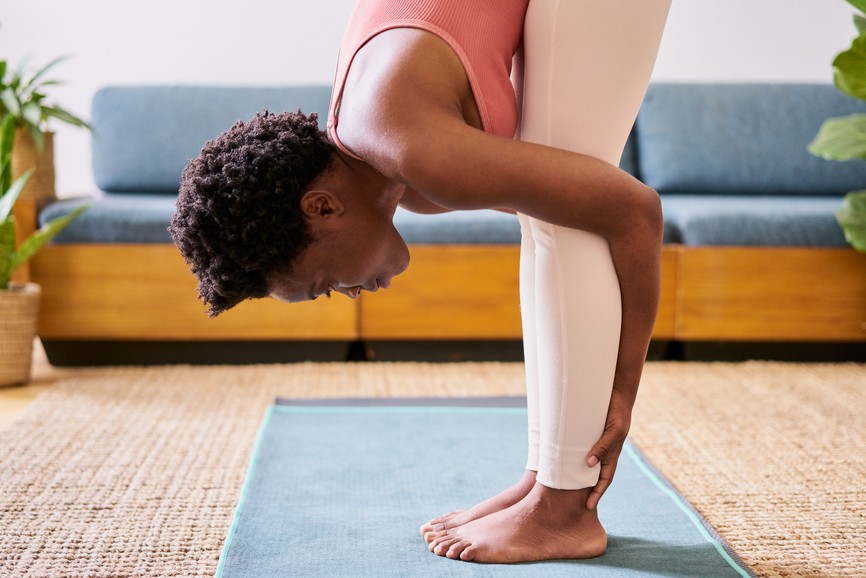During these first weeks of motherhood, you are in the middle of an evolution. And…
Movement
3 Ways to Regain Stability Physically and Mentally After Birth
June 19, 2021 • By Alissa Alter

I’m fascinated by relaxin. If you’re not familiar, it’s a hormone produced during pregnancy to soften smooth muscle (muscles that make up your organs and vessels vs skeletal muscles which move your bones around) and connective tissue (ligaments and tendons). It’s also responsible for a lot of magical things that happen in your body as you grow a tiny human, during the postpartum period, throughout milk production, and even a few months after you stop lactating.
So, what are these “magical” things I’m referring to? Well, thanks to good ole relaxin…
- Blood vessels stretch to accommodate higher blood volume. This is why your blood pressure drops during pregnancy.
- Digestion slows down so that you can extract as many nutrients as possible, including water. Which is why we can get constipated and everyone is telling you to drink water.
- Ligaments soften so that your body can expand during pregnancy. Your ribcage widens as your organs shift upward and your pelvis widens so make room for your baby to descend.
While this is all pretty miraculous, it comes with some less desirable things too. Think: your feet going up a half size due to all that movement and extra weight.
Since all of your ligaments are now soft, the structural integrity of your skeleton is compromised. Thankfully, your body is really smart and knows to find that stability somewhere. Cue the big muscle groups getting the job done, while your small stabilizing muscles take a backseat.
Now, you might be wondering…
“Is this why people say I’m more flexible during pregnancy?” Here’s a fact that might blow your mind: you aren’t. Flexibility relates to the ability of the muscles to lengthen or shorten. Range of motion relates more specifically to the freedom of movement within a joint.
So while relaxin causes an increased range of motion by softening ligaments and creating laxity in the joints, it doesn’t loosen or lengthen muscles which would create deeper flexibility. Since greater range of motion in your joints can cause strains, sprains, and tendonitis, we do have to be aware of overstretching. And to reduce the pressure on our joints and ligaments (which are designed to be pliable yet stable) it is important that we stretch our muscles to reduce injury.
Now, here’s the thing no one mentions. Relaxin sticks around postpartum. Boom. I said it.
If you are lactating, relaxin stays in your body, destabilizing everything until a few months after you wean. This is another reason why you feel so loosey goosey and smooshy postpartum. You are. That’s why it is so important to return to movement and exercise mindfully.
You are dealing with a compromised body. So to support your unstable, compromised, powerful, magical, sore postpartum body, start with breathing and then coordinate your breath with your movement to amplify and reintegrate your internal stability.
Here are my top three recommendations during pregnancy and postpartum to counteract the destabilization caused by relaxin and support your incredible mombod.
Breathe! I always recommend starting with breathing. I know. Annoying right? You’re ready to start moving and grooving and then I’m over like “Ok. So you are going to inhale for 4…” But it’s fundamental to supporting your body, your recovery, your mental health, and literally everything else in your body. Tuning into your breath allows your nervous system to literally calm down and bring you a feeling of safety and grounding. Learn more about the power of breath here.
Inhale all the way down into your pelvis. If you think of your pelvis having four bony landmarks, pubic bone, tailbone, and your two sit bones, they form a sort of diamond shape. As you inhale, feel the diamond lower and widen. As you exhale, feel it narrow and lift. This coordinates the muscles of your pelvic floor, transverse abdominals, and diaphragm, and recruits other support stabilizing muscles too! Learn more about giving your pelvic floor the love it needs postpartum here.
Clamshells. Old school, Jane Fonda clamshells. Lie on your side with your knees bent in a 90 degree angle. Keeping your toes together, lift your top knee up like how a clamshell opens when it’s fully cooked. SLOWLY lower back down. You can think of it being more work to lower than to lift. Keep an eye out if your top hip rolls back, and if it does, stop it! Keep your hips stacked and let the movement be IN the hip socket. For more info on movement for core stability, click here.
Balance on one foot. Start standing on both feet and make yourself stand ½ inch taller than you are. As you shift your weight to one foot, grow another ½ inch so you are taller on one leg than you are on two. This keeps you from sinking into your hips and NOT working the muscles we want to fire. Keep growing taller and slowly lower back to two feet before transferring your weight to the other leg. For more ways to find balance in your postpartum body click here.
Pay attention to how movement feels in your body instead of what it looks like. Your body is different now. There are new hormones, demands, and wounds that all need to settle and integrate into your life. You are healing from the inside out. So let’s rehabilitate from the inside out too.
I invite you to honor that state of your body, where you are right now, and focus on rebuilding your foundation as you get to know your new body and self.


